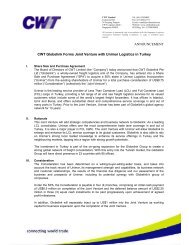notes to the financial statements - Investor Relations
notes to the financial statements - Investor Relations
notes to the financial statements - Investor Relations
Create successful ePaper yourself
Turn your PDF publications into a flip-book with our unique Google optimized e-Paper software.
CWT Limited<br />
60<br />
NOTES TO THE FINANCIAL STATEMENTS<br />
YEAR ENDED 31 DECEMBER 2011<br />
2 BASIS OF PREPARATION (CONT’D)<br />
2.5 Changes in Accounting Policies (cont’d)<br />
Overview (cont’d)<br />
Identification of related party relationships and related party disclosures<br />
From 1 January 2011, <strong>the</strong> Group applied <strong>the</strong> revised FRS 24 Related Party Disclosures (2010) <strong>to</strong> identify parties that are<br />
related <strong>to</strong> <strong>the</strong> Group and <strong>to</strong> determine <strong>the</strong> disclosures <strong>to</strong> be made on transactions and outstanding balances, including<br />
commitments, between <strong>the</strong> Group and its related parties. FRS 24 (2010) improved <strong>the</strong> definition of a related party in order<br />
<strong>to</strong> eliminate inconsistencies and ensure symmetrical identification of relationships between two parties.<br />
FRS 24 (2010) requires disclosure of transactions in all direct relationships involving control, joint control or significant influence<br />
and excludes <strong>the</strong> need <strong>to</strong> disclose transactions between two entities in which a person has significant influence over one<br />
entity, and a close family member of that person has significant influence over <strong>the</strong> o<strong>the</strong>r entity. Transactions and outstanding<br />
balances, including commitments, with <strong>the</strong>se related parties for <strong>the</strong> current and comparative years have been disclosed<br />
accordingly in note 44 <strong>to</strong> <strong>the</strong> <strong>financial</strong> <strong>statements</strong>.<br />
The adoption of FRS 24 (2010) affects only <strong>the</strong> disclosures made in <strong>the</strong> <strong>financial</strong> <strong>statements</strong>. There is no <strong>financial</strong> effect on<br />
<strong>the</strong> results and <strong>financial</strong> position of <strong>the</strong> Group for <strong>the</strong> current and previous <strong>financial</strong> years. Accordingly, <strong>the</strong> adoption of FRS<br />
24 (2010) has no impact on earnings per share.<br />
3 SIGNIFICANT ACCOUNTING POLICIES<br />
The accounting policies set out below have been applied consistently <strong>to</strong> all periods presented in <strong>the</strong>se <strong>financial</strong> <strong>statements</strong> and<br />
have been applied consistently by Group entities, except as explained in note 2.5, which addresses changes in accounting<br />
policies.<br />
3.1 Basis of consolidation<br />
Business combinations<br />
Business combinations are accounted for using <strong>the</strong> acquisition method as at <strong>the</strong> acquisition date, which is <strong>the</strong> date on which<br />
control is transferred <strong>to</strong> <strong>the</strong> Group. Control is <strong>the</strong> power <strong>to</strong> govern <strong>the</strong> <strong>financial</strong> and operating policies of an entity so as <strong>to</strong><br />
obtain benefits from its activities. In assessing control, <strong>the</strong> Group takes in<strong>to</strong> consideration potential voting rights that are<br />
currently exercisable.<br />
The consideration transferred does not include amounts related <strong>to</strong> <strong>the</strong> settlement of pre-existing relationships. Such amounts<br />
are generally recognised in profit or loss.<br />
Costs related <strong>to</strong> <strong>the</strong> acquisition, o<strong>the</strong>r than those associated with <strong>the</strong> issue of debt or equity securities, that <strong>the</strong> Group incurs<br />
in connection with a business combination are expensed as incurred.<br />
Any contingent consideration payable is recognised at fair value at <strong>the</strong> acquisition date. If <strong>the</strong> contingent consideration is<br />
classified as equity, it is not remeasured and settlement is accounted for within equity. O<strong>the</strong>rwise, subsequent changes <strong>to</strong> <strong>the</strong><br />
fair value of <strong>the</strong> contingent consideration are recognised in profit or loss.<br />
For non-controlling interests that are present ownership interests and entitle <strong>the</strong>ir holders <strong>to</strong> a proportionate share of <strong>the</strong><br />
acquiree’s net assets in <strong>the</strong> event of liquidation, <strong>the</strong> Group elects on a transaction-by-transaction basis whe<strong>the</strong>r <strong>to</strong> measure<br />
<strong>the</strong>m at fair value, or at <strong>the</strong> non-controlling interests’ proportionate share of <strong>the</strong> recognised amounts of <strong>the</strong> acquiree’s<br />
identifiable net assets, at <strong>the</strong> acquisition date. All o<strong>the</strong>r non-controlling interests are measured at acquisition-date fair value<br />
or, when applicable, on <strong>the</strong> basis specified in ano<strong>the</strong>r standard.





